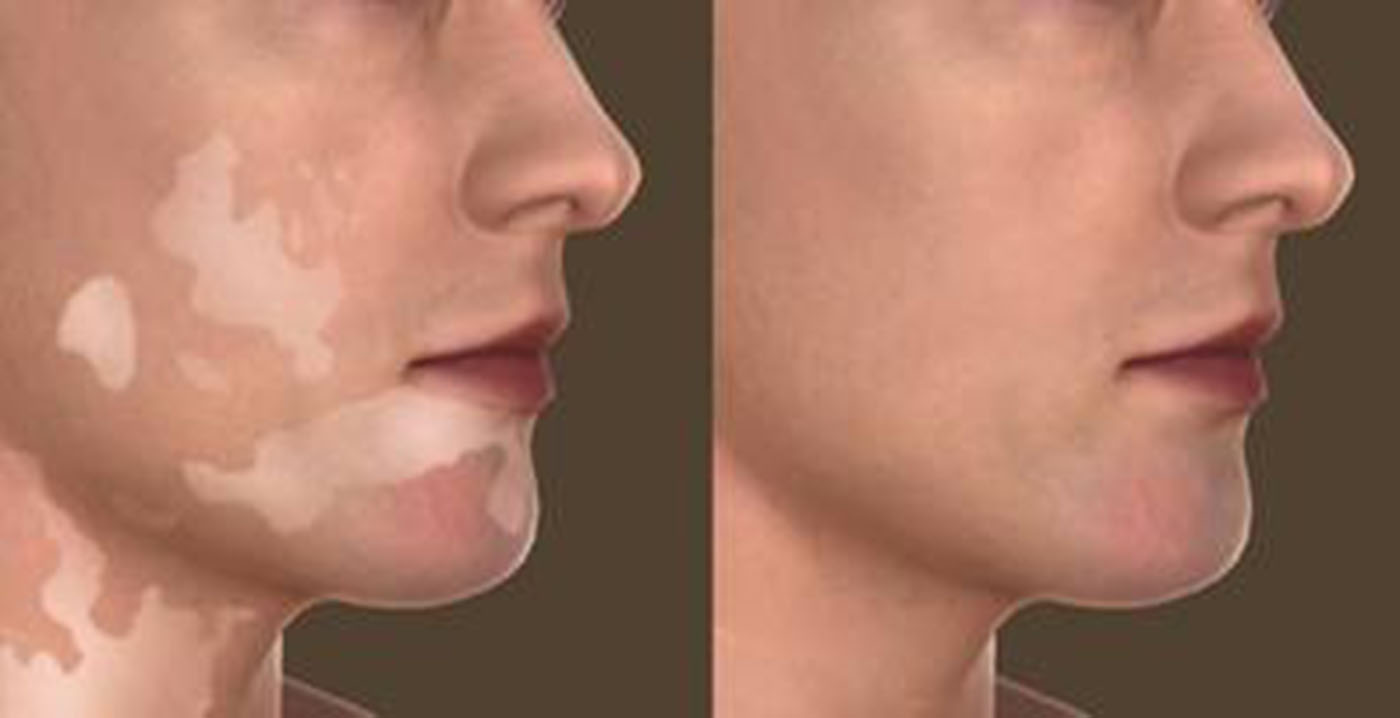Radiate your confidence.

Vitiligo
What is Vitiligo?
Vitiligo (vit-il-EYE-go) is a skin disorder that causes the skin to lose its color. Smooth white areas (called macules if less than 5mm or patches if 5mm or larger) appear on a person’s skin. If you have vitiligo in a place that has hair, the hair on your body may also turn white.
The condition occurs when melanocytes (the skin cells that produce melanin, the chemical that gives skin its color, or pigmentation) are destroyed by the body’s immune system.
Vitiligo usually begins with a few small white patches that may gradually spread over the body over the course of several months. Vitiligo typically begins on the hands, forearms, feet, and face but can develop on any part of the body, including the mucous membranes (moist lining of the mouth, nose, genital, and rectal areas), the eyes, and inner ears.
Sometimes the larger patches continue to widen and spread, but usually they stay in the same place for years. The location of smaller macules shifts and changes over time, as certain areas of skin lose and regain their pigments. Vitiligo varies in the amount of skin affected, with some patients experiencing few depigmented areas and others with widespread loss of skin color.

Types & Treatment
Types of Vitiligo Treatment?
![]() Generalized, which is the most common type, when macules appear in various places on the body.
Generalized, which is the most common type, when macules appear in various places on the body.![]() Segmental, which is restricted to one side of the body or one area, such as the hands or face.
Segmental, which is restricted to one side of the body or one area, such as the hands or face.
![]() Mucosal, which affects mucous membranes of the mouth and/or the genitals.
Mucosal, which affects mucous membranes of the mouth and/or the genitals.
![]() Focal, which is a rare type in which the macules are in a small area and do not spread in a certain pattern within one to two years.
Focal, which is a rare type in which the macules are in a small area and do not spread in a certain pattern within one to two years.
![]() Trichome, which means that there is a white or colorless center, then an area of lighter pigmentation, and then an area of normally colored skin.
Trichome, which means that there is a white or colorless center, then an area of lighter pigmentation, and then an area of normally colored skin.
![]() Universal, another rare type of vitiligo, and one in which more than 80% of the skin of the body lacks pigment.
Universal, another rare type of vitiligo, and one in which more than 80% of the skin of the body lacks pigment.
How is vitiligo treated?
There is no cure for vitiligo. The goal of medical treatment is to create a uniform skin tone by either restoring color (repigmentation) or eliminating the remaining color (depigmentation). Common treatments include camouflage therapy, repigmentation therapy, light therapy and surgery. Counseling may also be recommended.
Camouflage therapy:
![]() Using sunscreen with an SPF of 30 or higher. Also, the sunscreen should shield ultraviolet B light and ultraviolet A light (UVB and UVA). Use of sunscreens minimizes tanning, thereby limiting the contrast between affected and normal skin.
Using sunscreen with an SPF of 30 or higher. Also, the sunscreen should shield ultraviolet B light and ultraviolet A light (UVB and UVA). Use of sunscreens minimizes tanning, thereby limiting the contrast between affected and normal skin.
![]() Makeups help camouflage depigmented areas. One well-known brand is Dermablend®.
Makeups help camouflage depigmented areas. One well-known brand is Dermablend®.
![]() Hair dyes if vitiligo affects the hair.
Hair dyes if vitiligo affects the hair.
![]() Depigmentation therapy with the drug monobenzone can be used if the disease is extensive. This medication is applied to pigmented patches of skin and will turn them white to match the areas of vitiligo.
Depigmentation therapy with the drug monobenzone can be used if the disease is extensive. This medication is applied to pigmented patches of skin and will turn them white to match the areas of vitiligo.
Repigmentation therapy:
![]() Corticosteroids can be taken orally (as a pill) or topically (as a cream put on the skin). Results may take up to 3 months. The doctor will monitor the patient for any side effects, which can include skin thinning or striae (stretch marks) if used for a prolonged period.
Corticosteroids can be taken orally (as a pill) or topically (as a cream put on the skin). Results may take up to 3 months. The doctor will monitor the patient for any side effects, which can include skin thinning or striae (stretch marks) if used for a prolonged period.
![]() Topical vitamin D analogs.
Topical vitamin D analogs.
![]() Topical immunomodulators such as calcineurin inhibitors.
Topical immunomodulators such as calcineurin inhibitors.
Light therapy:
![]() Narrow band ultraviolet B (NB-UVB) requires two to three treatment sessions per week for several months.
Narrow band ultraviolet B (NB-UVB) requires two to three treatment sessions per week for several months.
![]() Excimer lasers emits a wavelength of ultraviolet light close to that of narrow band UVB. This is better for patients who do not have widespread or large lesions since it is delivered to small, targeted areas.
Excimer lasers emits a wavelength of ultraviolet light close to that of narrow band UVB. This is better for patients who do not have widespread or large lesions since it is delivered to small, targeted areas.
![]() Combining oral psoralen and UVA (PUVA) is used to treat large areas of skin with vitiligo. This treatment is said to be very effective for people with vitiligo in the areas of the head, neck, trunk, upper arms and legs.
Combining oral psoralen and UVA (PUVA) is used to treat large areas of skin with vitiligo. This treatment is said to be very effective for people with vitiligo in the areas of the head, neck, trunk, upper arms and legs.
Surgery:
![]() Autologous (from the patient) skin grafts: Skin is taken from one part of the patient and used to cover another part. Possible complications include scarring, infection or a failure to repigment. This might also be called mini grafting.
Autologous (from the patient) skin grafts: Skin is taken from one part of the patient and used to cover another part. Possible complications include scarring, infection or a failure to repigment. This might also be called mini grafting.
![]() Micropigmentation: A type of tattooing that is usually applied to the lips of people affected by vitiligo.
Micropigmentation: A type of tattooing that is usually applied to the lips of people affected by vitiligo.
Counseling:
![]() Vitiligo can cause psychological distress and has the ability to affect a person’s outlook and social interactions. If this happens, your caregiver may suggest that you find a counselor or attend a support group.
Vitiligo can cause psychological distress and has the ability to affect a person’s outlook and social interactions. If this happens, your caregiver may suggest that you find a counselor or attend a support group.
How can I prevent Vitiligo?
Since no one knows for certain what causes vitiligo, no one can tell you how to prevent it. In general, it is smart for everyone to practice safe sun exposure habits and to take good care of your skin.
Clinic Timings
Mon-Sat: 10:00 AM - 7:00 PM
Sunday : Closed
Location
Room no. 8, Lifecare Hospital, Near Cantt, Chauraha,
Gorakhpur
Book An Appointment
Why Choose us
Dr. Dekid Palmo provides the most advanced, safe, and customized treatments. Also, equipped with world-class lasers and state of the art technology and experienced staff.
